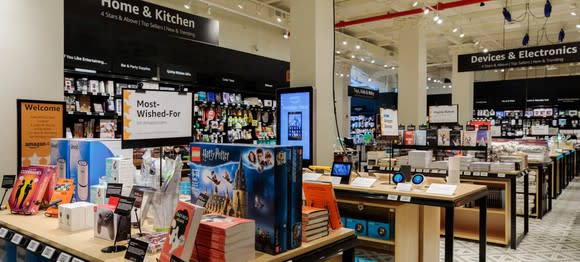3 Top Tech Stocks to Buy Right Now
Investors looking to get the most bang for their buck ultimately will want at least a portion of their portfolios in technology issues, and here's why: While the broader market, as represented by the S&P 500, has gained an impressive 16% over the past 12 months, the tech-heavy Nasdaq Composite is up nearly 24%. That's not a fluke, either, as the tech benchmark has outperformed the broader market over the past three-, five-, and 10-year periods. In fact, the 288% increase of the Nasdaq nearly doubles the 152% gain the S&P achieved over the past decade.
With that in mind, we asked three Fool.com contributors to identify tech stocks with room to run in the years to come. Read on to find out why they chose Appian (NASDAQ: APPN), NVIDIA (NASDAQ: NVDA), and Amazon (NASDAQ: AMZN).

Image source: Getty Images.
App development for the masses
Brian Stoffel (Appian): Any company that wants to thrive in the 21st century needs a convenient way for its customers to conduct business. Apps are by far the most popular mode to fill that need. Unfortunately, developing apps isn't easy -- it requires a dedicated staff of coders who can consistently monitor and update a tool over time. Only companies with large budgets can afford that.
Enter Appian, which provides a "low-code" way for just about any company to develop its own apps. The company was founded and still is run by CEO Matt Calkins -- who owns 46.5% of shares outstanding and controls over half the company's voting rights. Calkins has a bold goal: to cut the time needed to develop apps by 50% every two years. Companies that use the platform pay a subscription rate based on the number of their apps' end users -- making it a scalable solution for companies of all sizes.
The stock isn't without risk. In chasing market share right now, the company still is years away from turning a profit; over the past 12 months, it bled out $29 million in free cash flow. And yet, Appian's revenue-retention rate of 119% last quarter convinces me that the company is not only keeping its customers for the long haul, but getting them to add more functionality over time -- a recipe for long-term success.

Image source: Getty Images.
Next-gen GPUs face their first hurdle -- "ho-hum" reviews
Nicholas Rossolillo (NVIDIA): Yup, I'm talking NVIDIA again. That's because, after initial optimism by investors over second-quarter results wore off, the stock is in decline again. This time, it's because the initial performance reviews on its new artificial intelligence (AI)-powered ray tracing graphics processing units (GPUs) are coming in more poorly than hoped for. Even analysts at Morgan Stanley weighed in and called the performance disappointing.
Of course the performance was "disappointing." Ray tracing won't be enabled on computers until operating systems roll out updates for it. Microsoft said that won't come until October with its next big Windows 10 update. Plus, only a few games even are able to make use of the new graphics-rendering tech. Thus, the substantially higher pricing for the new GPUs for minimal performance gains in older games isn't worth the money. NVIDIA's other GPUs for gaming, which were released last year, will still get the job done just fine.
While that could limit the immediate upside potential for the company's gaming segment -- which accounted for 58% of revenue and grew 52% year over year in the last quarter -- there's a lot more to the new GPUs than better video game graphics. This is all about opening up new growth opportunities, not just building on existing ones, a strategy that NVIDIA has been successfully executing the last few years.
The ray tracing-enabled chips could help revolutionize the way digital designers and artists work. Ray tracing and the lifelike images and video it creates require some serious computing power. Think of things like special effects in movies. Even short scenes that feature computer-generated images can cost tens of thousands of dollars, as they need to be farmed out to data centers and can take a lot of time to produce.

NVIDIA's ray tracing technology is gaming's "Holy Grail." Image source: NVIDIA.
NVIDIA is optimistic its new chips will open up the $250 billion special-effects industry and help other aspects of its professional visualization segment that services companies in the fields of architecture, engineering, and manufacturing. Total sales from that segment last quarter were only $281 million, a mere 9% of the total. Ray tracing and AI could help change that, giving more reason to give the stock a look.
So much more than digital sales
Danny Vena (Amazon): Considering the stock has doubled over the past year, investors might feel they've missed the boat on Amazon. Yet even as the company briefly topped a $1 trillion market cap just one month ago, I think that's just the beginning.
It's no secret that Amazon Web Services (AWS) -- the company's cloud-computing operation -- is its cash cow, with sales increasing 43% year over year in 2017. AWS revenue is up 49% so far this year and produced 11% of Amazon's total sales, as well as the bulk of its profits. The cloud Infrastructure-as-a-Service (IaaS) market is expected to more than double between 2018 and 2021, and one analyst thinks this could help Amazon triple its cloud business within five years.
Amazon also is creating an ecosystem around its e-commerce experience. The company announced it had more than 100 million Prime members earlier this year, which entitles them to free two-day shipping, streaming music and video, and more. The plethora of Alexa-powered hardware is another way Amazon is engaging with its customers, currently controlling an estimated 70% of the smart-speaker market.
Amazon's growing number of brick-and-mortar locations, including Whole Foods, bookstores, cashier-free convenience stores, and its recently announced 4-Star -- which sells only the site's most popular items -- are giving customers new ways to shop on Amazon.

Amazon's new 4-Star store. Image source: Amazon.
Advertising is another area of recent focus by the company, topping $2 billion in sales in each of the two previous quarters. That growth recently has accelerated, up 132% and 139%, respectively, year over year in the first and second quarters of this year.
Finally, Amazon's e-commerce realm is becoming more profitable, as steadily improving margins bode well for the future. With its growing list of revenue generators and improving bottom line, Amazon could, according to one bullish analyst, be well on its way to a $2 trillion market cap within three to five years -- more than double its current worth.
This all spells an opportunity that investors should consider tapping right now.
More From The Motley Fool
John Mackey, CEO of Whole Foods Market, an Amazon subsidiary, is a member of The Motley Fool's board of directors. Teresa Kersten is an employee of LinkedIn and is a member of The Motley Fool's board of directors. LinkedIn is owned by Microsoft. Brian Stoffel owns shares of Amazon. Danny Vena owns shares of Amazon, Appian, and Nvidia. Nicholas Rossolillo owns shares of Appian, Microsoft, and Nvidia. The Motley Fool owns shares of and recommends Amazon, Appian, and Nvidia. The Motley Fool has a disclosure policy.

 Yahoo Finance
Yahoo Finance 